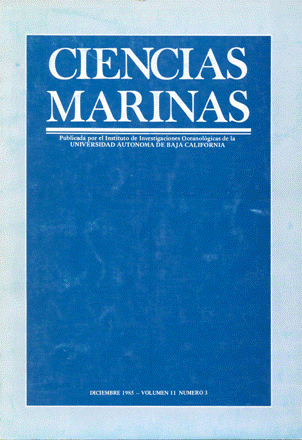Comparative study of the degree of incidence of macroparasites in six species of sebastes (Pisces, Scorpaenidae) from the northwestern coast of Baja California, Mexico
Main Article Content
Abstract
A qualitative and quantitative study on infestation levels by macroparasites was carried out for six rockfish species of the genus Sebastes (S. constellatus, S. elongatus, S. rosaceus, S. umboxus, S. helvomaculatus and S. chlorostictus). This analysis was made on 220 specimens from commercial catches from Apri1 1989 to February 1990, in several localities along the northwestem coast of Baja California, Mexico, between Coronado Island and San Quintín Bay. The number of macroparasites on the different affected organs was analysed for each rockfish species, as well as for each size class and sex. The nematode (Anisakis sp.) and monogenea tremato de (Microcotyle sp.) were registered in all the species of rockfish but others, such as the anchar parasite copepod (Lemaea sp.) and digenea trematode (Opecoelus sp.), were of exclusive occurrence in S. umbrosus and S. rosaceus, respectively. Nematodes were the most dominant parasites in all the rockfish species, with an incidence percent of 82.4, followed by digenea trematodes (9.5%) and cestode worms (3.1%). The average number of macroparasites was different among the six rockfish species, being S. helvomaculatus the species with higher number of macroparasites. The average number of macroparasites between sexes was different for each rockfish species, except in S. constellatus. We did not register significant differences in the average number of parasites among size classes for each rockfish species.
Downloads
Article Details
This is an open access article distributed under a Creative Commons Attribution 4.0 License, which allows you to share and adapt the work, as long as you give appropriate credit to the original author(s) and the source, provide a link to the Creative Commons license, and indicate if changes were made. Figures, tables and other elements in the article are included in the article’s CC BY 4.0 license, unless otherwise indicated. The journal title is protected by copyrights and not subject to this license. Full license deed can be viewed here.

